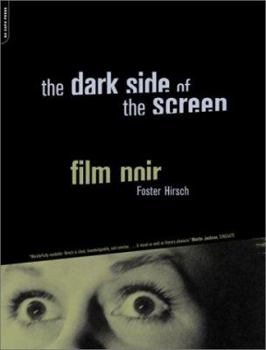The Dark Side of the Screen: Film Noir
Select Format
Select Condition 
Book Overview
Foster Hirsch's Dark Side of the Screen is by far the most thorough and entertaining study of the themes, visual motifs, character types, actors, directors, and films in this genre ever published.... This description may be from another edition of this product.
Format:Paperback
Language:English
ISBN:0306810395
ISBN13:9780306810398
Release Date:March 2001
Publisher:Da Capo Press
Length:248 Pages
Weight:1.35 lbs.
Dimensions:0.6" x 8.4" x 10.4"
Customer Reviews
4 ratings
Fade to Black -- Nothing But Night
Published by Thriftbooks.com User , 14 years ago
This is an impressive book of film criticism by a scholar who is knowledgeable and enthusiastic, but most importantly capable of writing in accessible prose that does not require a semester long course in film studies to understand. Foster Hirsch's book has withstood the test of time and it remains relevant almost three decades after its initial publication. There are a minimum number of minor errors in the text, (usually simple transpositions of the names of cast and crew members), but it must be remembered that Professor Hirsch completed his original manuscript before films were widely available on videotape for home viewing. Hirsch actually had to seek out hundreds of film titles to view in a screening room and write his impressions from memory afterwards. I especially appreciated Hirsch's editorial decision to include ample material on the novelists and short story writers who provided much of the literature that gave rise to the film noir cycle. The latest edition of the book includes an afterword added by the author which revisits older topics, examines film titles omitted from the original book and delves into the rise of the "Neo-noir" genre of filmmaking. I highly recommend this book for any film noir enthusiast. I had the good fortune to meet Foster Hirsch at a recently concluded film festival where he spoke and I had the opportunity to converse with him. Reading the high quality essays contained in this book is the next best thing.
One of the 1st Film Noir Books. Still a Solid Introduction.
Published by Thriftbooks.com User , 18 years ago
First published in 1981, "The Dark Side of the Screen" was among the first books in English on the subject of film noir. Author Foster Hirsch revisits that time before film noir was a fashionable subject in his introduction to this 2001 edition. More than 2 decades after its publication, "The Dark Side of the Screen" is still a solid introduction to film noir history, although it lacks discussion of the neo-noir films that have been made since its publication and has not been influenced by more recent theories. If you are new to classic film noir, this book is not a bad place to start. It is very readable, discusses or mentions over 100 films, and the large format (8.5"x11") allows for over 180 black-and-white photographs. "The Dark Side of the Screen" contains basic information on the film noir movement that you are likely to find in any good introductory text, so it's not intended for those already well-versed in the subject. In eight chapters, Hirsch follows the film noir movement through its classic period, 1941 to the late 1950s, until its self-conscious revival in the 1970s. "The Dark Side of the Screen" starts out with an overview of typical noir themes and summary of the style's evolution, then takes a step back in time to film noir's sources, obvious and alleged, in American hard-boiled crime literature, German Expressionist art, and Italian Neo-Realist cinema. Hirsch summarizes noir's narrative and visual style before discussing key directors, mainly German émigrés and Americans, and many of the important names among film noir actors, with analysis of the typical film noir acting style. The book concludes with a useful, though occasionally forced, attempt to categorize film noir's basic narrative patterns and central figures and a brief discussion of neo-noir. Like all historians and theorists, Foster Hirsch has opinions. His assertion that film noir is a "genre" and his presumption that its low-key lighting is "borrowed directly" or "clearly indebted" to German Expressionism become increasingly controversial as time passes. I mention this so that film noir aficionados know where he's coming from and to caution tyros that many ideas about film noir are controversial, so take everything with a grain of salt until you've formed your own opinions. But there is no reason not to start forming them with "The Dark Side of the Screen", which provides a nice overview of the classic film noir movement and lots of good film recommendations.
Dark Side of the Screen is shining light!
Published by Thriftbooks.com User , 22 years ago
Hirsch's brilliant analysis of the antecedents, key period and legacy of noir remains perhaps the finest single work on the subject. Not as funny or entertaining as Eddie Muller's 'Dark City', but a major work that pre-dates many inferior later studies. Especially notable is Hirsch's use of stills, his choice of key scenes (e.g. Panic in the Streets, the Phenix City Story, Scarlet Street) skilfully differentiates between studio shot film noirs and pseudo-documentary/location filmed noirs.Highly recommended for serious lovers of the genre (not room enough here to debate whether film noir is a genre or not!) and ranks, for me, alongside Paul Schrader's legendary 'Notes on Film Noir' essay (1972) as the single most important piece of work on the subject.
This book contains an excellent account of noir stylistics
Published by Thriftbooks.com User , 25 years ago
I found this book to be a concise and relevant exploration of the history, style and themes of film noir. It was immensely helpful as a research source for an essay I did on noir styles and themes. With clear explanations and pictorial examples it bestowed upon me a clear and precise understanding of the genre.





